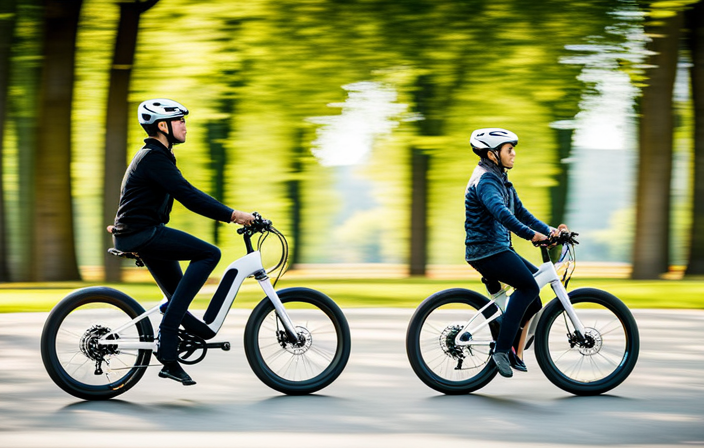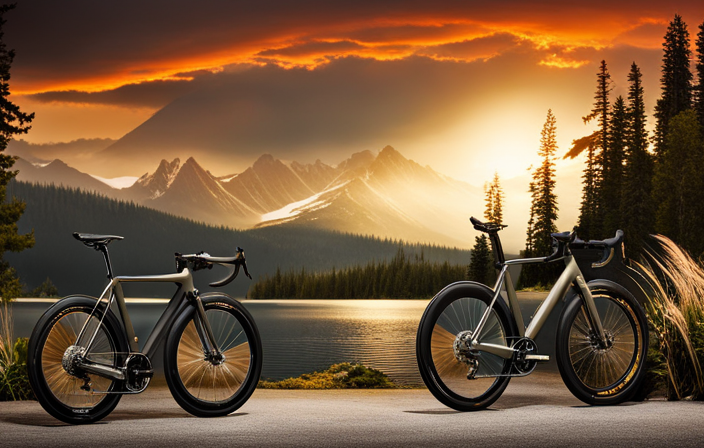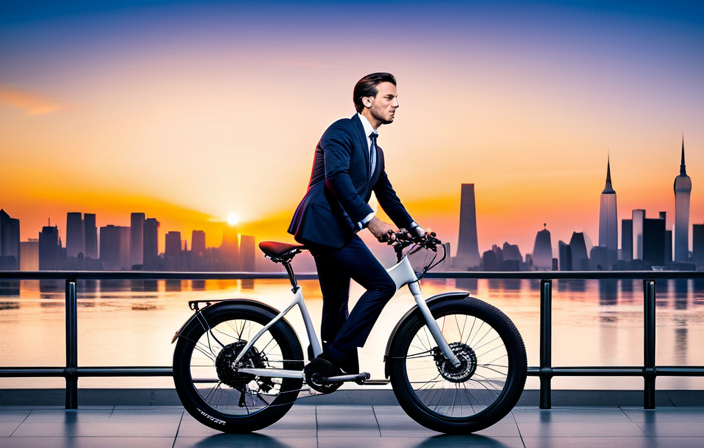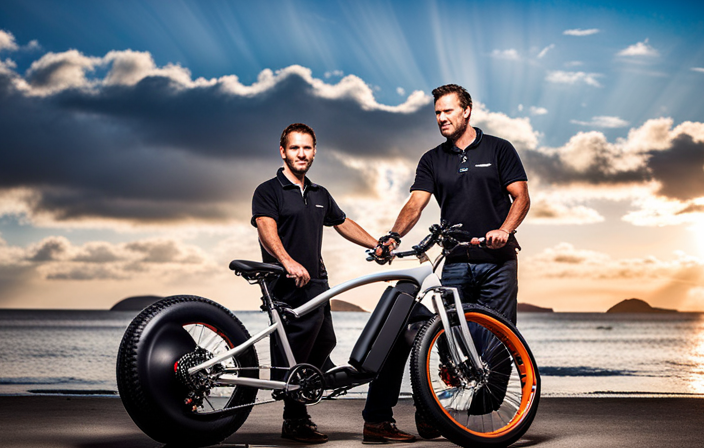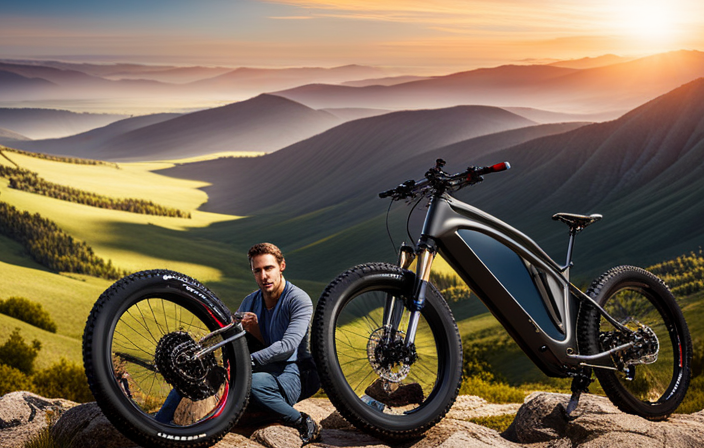Ever been curious about the top speed of an electric bike? Well, get ready to delve into the realm of electric bike velocities.
Just like the wind rushing through your hair, electric bikes have become a popular mode of transportation, combining the convenience of a bicycle with the power of electricity.
In this article, we’ll explore the average speed of electric bikes, the factors that affect their velocity, and the regulations and laws surrounding their maximum speeds.
So, let’s pedal our way through the fascinating world of electric bike speed!
Key Takeaways
- Electric bikes can reach speeds of up to 20-28 mph.
- Regulations and laws regarding electric bike speed vary from country to country, with the maximum speed limit in the US being 20 mph.
- Impressive speed records and achievements in electric biking showcase the capabilities and drive innovation in the industry.
- Factors to consider when choosing an electric bike for speed include acceleration capabilities, battery power optimization, weight of the bike, and advancements in motor and battery technology.
Understanding Electric Bikes
If you’re looking to understand electric bikes, you’ll want to know what the average speed of an electric bike is. Electric bike technology has come a long way in recent years, offering a range of benefits that make them an attractive option for many riders.
One of the key advantages of electric bikes is their ability to reach higher speeds compared to traditional bicycles. On average, electric bikes can reach speeds of around 20 to 28 miles per hour, depending on various factors such as the motor power, battery capacity, and terrain. These higher speeds allow riders to cover longer distances in less time, making them a convenient and efficient mode of transportation.
Now, let’s delve into how electric bikes work and the mechanics behind their impressive speed.
How Electric Bikes Work
Electric bikes operate by utilizing an electric motor to assist with propulsion. This technology has revolutionized the world of cycling, offering numerous benefits to riders. Here are three key aspects of electric bike technology that make them so popular:
-
Electric motor: The heart of an electric bike, the motor provides additional power to the rider’s pedaling. This enables riders to effortlessly tackle hills and cover long distances without breaking a sweat.
-
Battery: Electric bikes are equipped with a rechargeable battery that powers the motor. These batteries have significantly improved in recent years, offering longer ranges and faster charging times, making electric bikes more practical than ever.
-
Pedal-assist modes: Electric bikes usually come with different pedal-assist modes, allowing riders to choose the level of assistance they want. This feature enhances the overall cycling experience and ensures that riders have control over their speed and effort.
Electric bikes have taken the cycling world by storm, offering a greener and more efficient way to travel. In the next section, we will explore the different types of electric bikes available.
Types of Electric Bikes
When choosing a new ride, you’ll find various types of electric bikes available to suit your preferences and needs. Whether you’re looking for a sleek and stylish urban commuter or a rugged off-road adventurer, there’s an electric bike for you.
Some popular electric bike brands include Trek, Specialized, and Rad Power Bikes. These brands offer a wide range of electric bikes with different features and specifications. Additionally, there are various electric bike accessories available to enhance your riding experience, such as lights, fenders, and racks. These accessories can be customized to fit your specific needs.
Understanding the different types of electric bikes and the accessories they offer can help you make an informed decision. Now, let’s dive into the factors that affect electric bike speed.
Factors Affecting Electric Bike Speed
One of the key factors that can impact how fast an e-bike travels is the terrain it is being ridden on. The type of terrain can greatly influence the speed and acceleration of an electric bike. Steeper inclines or rougher surfaces can slow down an e-bike, while flat, smooth roads can allow for faster speeds. Additionally, factors such as wind resistance and weight can also affect the speed of an electric bike. When riding on uphill terrain, the electric motor may need to work harder to maintain speed, resulting in slower acceleration. On the other hand, riding on downhill terrain can lead to faster speeds due to the assistance of gravity. These factors all contribute to the overall average speed of an electric bike. Moving on to the subsequent section about maximum speed limits for electric bikes, it is important to consider these factors when determining the safe and appropriate maximum speed.
Maximum Speed Limits for Electric Bikes
To determine the maximum speed limits for your e-bike, take into account factors such as terrain, wind resistance, weight, and assistance from gravity on downhill slopes. Electric bike speed limits are regulated by various jurisdictions around the world.
In the United States, for example, the federal law sets a maximum speed limit of 20 mph for electric bikes that are equipped with a motor providing assistance up to that speed. However, states can also set their own regulations, which may vary.
In Europe, the speed limit for electric bikes is usually set at 25 km/h (15.5 mph), although there are some exceptions. These speed limits are in place to ensure the safety of riders and other road users.
Classifying electric bikes by speed is an important aspect of understanding their capabilities and legal requirements.
Classifying Electric Bikes by Speed
Classifying e-bikes by their maximum permissible speed is essential for understanding their different categories and legal requirements. When it comes to electric bike acceleration and speed control mechanisms, manufacturers have developed various designs to cater to different needs and regulations. To give you an idea of the speed classifications, here’s a table:
| Class | Maximum Speed | Typical Use |
|---|---|---|
| Class 1 | 20 mph | Commuting and recreational rides |
| Class 2 | 20 mph | Commuting and off-road rides |
| Class 3 | 28 mph | Commuting and sporty rides |
| Class 4 | 28+ mph | Off-road and racing |
These classifications help riders and authorities determine where electric bikes can be used legally. Now, let’s delve into the average speed of electric bikes in different settings, which will provide a broader understanding of their capabilities and limitations.
Average Speed of Electric Bikes in Different Settings
Now that we have classified electric bikes by speed, let’s dive into the average speed of electric bikes in different settings.
Understanding the average speed of electric bikes is crucial for both riders and manufacturers. When it comes to speed limits, electric bikes are subject to different regulations depending on the country and region. To determine the average speed, speed testing is conducted in controlled environments to ensure accuracy and consistency.
Here are some key factors that influence the average speed of electric bikes:
- Terrain: Whether you’re riding uphill or on flat ground, the terrain greatly affects the average speed.
- Battery Level: As the battery depletes, the speed may decrease.
- Weight: The weight of the rider and any additional cargo can impact the average speed.
- Riding Style: Aggressive riding or maintaining a steady pace can influence the overall speed.
Understanding these factors can help riders optimize their electric bike’s performance.
Now, let’s explore some tips for increasing electric bike speed.
Tips for Increasing Electric Bike Speed
If you want to go faster on your e-bike, here are some tips to help you increase your speed.
Increasing acceleration is key to reaching higher speeds, and one way to do this is by optimizing your gear ratio. It’s important to find the best gear ratio that allows you to maintain a comfortable cadence while maximizing power transfer to the wheels.
Experiment with different gear combinations to find the sweet spot that suits your riding style and terrain. Additionally, maintaining proper tire pressure is crucial for reducing rolling resistance and increasing efficiency. Make sure your tires are adequately inflated to ensure optimal speed.
By implementing these tips, you can boost your electric bike’s performance and enjoy a faster ride.
Now, let’s delve into safety considerations for high-speed electric biking.
Safety Considerations for High-Speed Electric Biking
When riding at high speeds on an e-bike, it’s important to prioritize safety and take necessary precautions. Electric bike accidents can be more severe at high speeds due to the increased momentum and potential loss of control. To ensure your safety, make sure to wear appropriate safety gear for high-speed biking. This includes a well-fitting helmet, protective gloves, and sturdy shoes. Additionally, consider investing in knee and elbow pads for added protection.
To further enhance your safety, here are four important tips to keep in mind:
- Maintain a safe distance from other vehicles and pedestrians to avoid collisions.
- Always obey traffic laws and signals to minimize the risk of accidents.
- Be aware of your surroundings and anticipate potential hazards on the road.
- Regularly check and maintain your electric bike to ensure it is in good working condition.
By following these safety considerations, you can minimize the risk of accidents and enjoy your high-speed electric biking experience.
Now, let’s delve into comparing electric bike speed to traditional bicycles.
Comparing Electric Bike Speed to Traditional Bicycles
To compare the speed of an electric bike to a traditional bicycle, you’ll notice a significant difference in your riding experience. Electric bikes are equipped with a motor that enables them to reach higher speeds compared to traditional bikes, giving you a faster and more efficient way to get around. When comparing electric bike speed to other modes of transportation, such as scooters, electric bikes often come out on top. They offer similar speeds to scooters, while providing the added benefit of being eco-friendly and requiring less effort from the rider. In fact, electric bikes can reach speeds of up to 20 to 28 miles per hour, depending on the model and the power of the motor. This increased speed not only allows you to reach your destination faster, but it also provides a thrilling and exhilarating riding experience. Transitioning into the subsequent section about ‘speed records and achievements in electric biking’, you’ll discover even more impressive feats in the world of electric biking.
Speed Records and Achievements in Electric Biking
Now that you understand the difference in speed between electric bikes and traditional bicycles, let’s delve into the world of speed challenges and world records in electric biking.
The electric bike community has seen some impressive achievements in terms of speed. From time trials to speed races, enthusiasts have pushed the limits of these machines. One notable accomplishment is the world record for the fastest electric bike, which currently stands at an astonishing 183.9 miles per hour.
These speed challenges not only showcase the capabilities of electric bikes but also drive innovation in the industry. However, with such impressive speeds comes the need for regulations and laws regarding electric bike speed.
Let’s explore the rules and guidelines that govern the speed of electric bikes in the next section.
Regulations and Laws Regarding Electric Bike Speed
Regulations and laws dictate the maximum velocity an electric bicycle can reach. Electric bike speed regulations vary from country to country and even within different regions of the same country. In the United States, for example, the maximum speed limit for electric bikes is typically set at 20 mph, while in Europe, it can range from 15.5 mph to 28 mph, depending on the country. To provide a clearer understanding, the table below summarizes the speed limits for electric bikes in selected countries:
| Country | Maximum Speed Limit (mph) |
|---|---|
| United States | 20 |
| Germany | 15.5 |
| Netherlands | 15.5 |
| France | 15.5 |
| United Kingdom | 15.5 |
These speed limits are put in place to ensure the safety of both riders and pedestrians. They help prevent accidents and promote responsible use of electric bikes. Understanding these regulations is essential for riders to comply with the law and make informed decisions when it comes to electric bike speed. Moving forward, let’s explore the various speed testing and measurement methods for electric bikes.
Speed Testing and Measurement Methods for Electric Bikes
One commonly used method for measuring the velocity of electric bikes is through GPS tracking. This technique utilizes satellites to accurately determine the speed of an electric bike. GPS tracking offers a reliable and precise way to measure the speed of electric bikes, ensuring accurate data for analysis and comparison.
To evoke emotion in the audience, consider the following bullet list:
- Increased accuracy: GPS tracking provides highly accurate speed measurements, allowing for precise analysis and comparison of electric bike speeds.
- Real-time monitoring: With GPS tracking, electric bike speeds can be monitored in real-time, providing instant feedback on performance.
- Versatility: GPS tracking can be used in various terrains and conditions, ensuring accurate speed measurement regardless of the environment.
- Consistency: GPS tracking eliminates human error and provides consistent speed measurements, ensuring reliable data for analysis.
- Efficiency: The use of GPS tracking for speed testing reduces the need for manual timing methods, making the process more efficient and streamlined.
Considering the accuracy of speed measurement techniques, it is important to also take into account other factors when choosing an electric bike for speed.
Factors to Consider When Choosing an Electric Bike for Speed
When choosing an electric bike for speed, you’ll want to consider various factors.
One important factor is the bike’s acceleration capabilities. Look for a bike that offers increasing acceleration, as this will allow you to quickly reach higher speeds.
Another factor to consider is the bike’s battery power optimization. A bike with efficient battery usage will be able to maintain higher speeds for longer periods of time.
Additionally, consider the weight of the bike. Lighter bikes tend to have better speed performance.
Finally, look for bikes with advanced motor technology and aerodynamic designs, as these can also contribute to increased speed.
Considering these factors will help you find an electric bike that can offer you the speed you desire.
Looking towards future innovations and trends in electric bike speed, the industry is continuously working on improving the performance of electric bike motors and batteries.
Future Innovations and Trends in Electric Bike Speed
In the future, we can expect to see advancements in motor and battery technology that will enhance the speed capabilities of e-bikes. With ongoing research and development, manufacturers are constantly seeking ways to improve the performance of electric bikes.
Future developments in motor technology will likely result in more powerful and efficient motors, allowing for higher speeds. Additionally, advancements in battery technology will enable e-bikes to have longer range and faster charging times. These advancements will not only improve the overall speed of electric bikes, but also enhance their usability and convenience.
Technological advancements will also play a role in the design of e-bikes, with lighter and more aerodynamic frames being developed to further improve speed. As the electric bike industry continues to grow, we can expect to see exciting innovations that will push the boundaries of speed and performance.
Frequently Asked Questions
Can an electric bike go faster than the maximum speed limit?
Yes, an electric bike can go faster than the maximum speed limit based on riding techniques and the impact of terrain.
By utilizing techniques such as optimizing pedal assist levels and maintaining an aerodynamic position, riders can achieve higher speeds.
Additionally, electric bikes can easily handle different terrains, allowing riders to maintain a consistent pace.
However, it is important to always prioritize safety and abide by local regulations to ensure a smooth and enjoyable riding experience.
Are there any legal restrictions on the maximum speed of an electric bike?
Electric bike speed regulations vary by country and region. In many places, there are legal speed restrictions for e-bikes.
For example, in the United States, federal law limits the maximum speed of electric bikes to 20 mph when the motor is engaged. However, some states have their own regulations that may be more restrictive.
It is important to familiarize yourself with the specific legal requirements in your area to ensure compliance with electric bike speed regulations.
What is the average speed of an electric bike when riding uphill?
When tackling uphill terrain, electric bikes face a challenging battle of gravity. The average uphill speed of an electric bike is influenced by a range of factors.
These include the power of the electric motor, the capacity of the battery, the weight of the rider, and the steepness of the incline. Climbing hills demands more energy, which may decrease the average speed compared to riding on flat surfaces.
Can the weight of the rider affect the speed of an electric bike?
The weight of the rider can indeed have an impact on the speed of an electric bike. A heavier rider may experience slightly slower speeds compared to a lighter rider due to the increased load on the motor.
Additionally, the rider’s body position can also affect the bike’s aerodynamics, potentially influencing speed.
However, it’s important to note that these effects are typically minimal and can be mitigated by the bike’s motor power and overall design.
Are there any limitations to the speed of an electric bike when riding in different weather conditions?
When riding an electric bike in different weather conditions, there are limitations to its speed. Rain can reduce the traction between the tires and the road, making it harder for the bike to maintain high speeds. Additionally, strong winds can create resistance, slowing down the bike.
It is important to be cautious and adjust your speed accordingly in these conditions. It is recommended to ride at a safe and manageable speed to ensure your safety and control.
Conclusion
So there you have it, fellow rider! After diving deep into the world of electric bikes and exploring factors that affect their speed, it’s clear that these futuristic two-wheelers have a lot to offer.
With average speeds ranging from 15 to 28 miles per hour, electric bikes can whisk you away to your destination in a flash. But remember, regulations and laws vary, so make sure to stay up to date.
And who knows what the future holds? With constant innovations and trends, electric bike speed is bound to soar to new heights. So hop on, embrace the electric thrill, and pedal into a faster and greener tomorrow!
